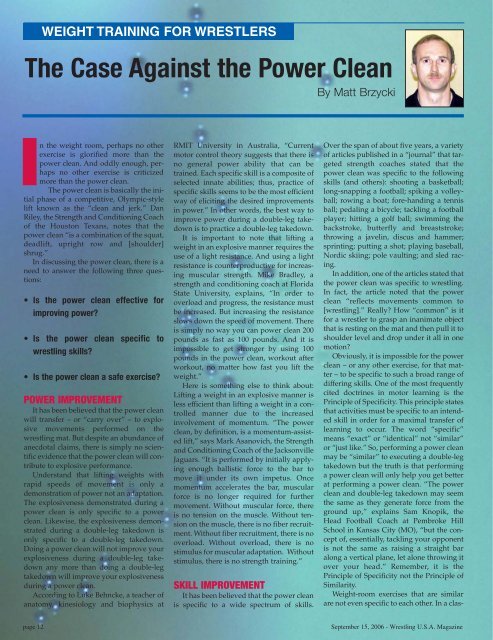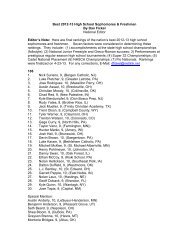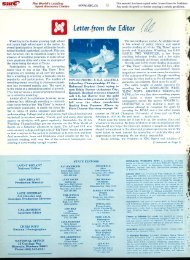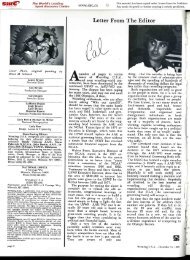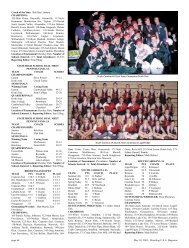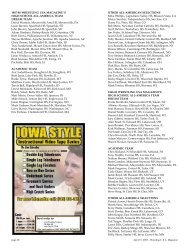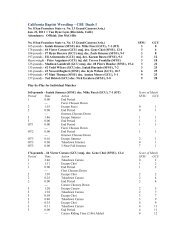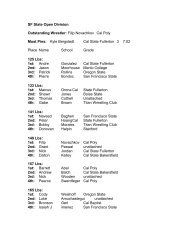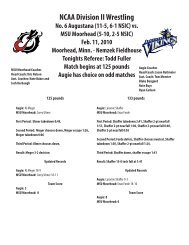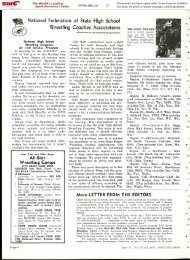The Case Against the Power Clean - Wrestling USA Magazine
The Case Against the Power Clean - Wrestling USA Magazine
The Case Against the Power Clean - Wrestling USA Magazine
You also want an ePaper? Increase the reach of your titles
YUMPU automatically turns print PDFs into web optimized ePapers that Google loves.
In <strong>the</strong> weight room, perhaps no o<strong>the</strong>r<br />
exercise is glorified more than <strong>the</strong><br />
power clean. And oddly enough, perhaps<br />
no o<strong>the</strong>r exercise is criticized<br />
more than <strong>the</strong> power clean.<br />
<strong>The</strong> power clean is basically <strong>the</strong> initial<br />
phase of a competitive, Olympic-style<br />
lift known as <strong>the</strong> “clean and jerk.” Dan<br />
Riley, <strong>the</strong> Strength and Conditioning Coach<br />
of <strong>the</strong> Houston Texans, notes that <strong>the</strong><br />
power clean “is a combination of <strong>the</strong> squat,<br />
deadlift, upright row and [shoulder]<br />
shrug.”<br />
In discussing <strong>the</strong> power clean, <strong>the</strong>re is a<br />
need to answer <strong>the</strong> following three questions:<br />
• Is <strong>the</strong> power clean effective for<br />
improving power?<br />
• Is <strong>the</strong> power clean specific to<br />
wrestling skills?<br />
• Is <strong>the</strong> power clean a safe exercise?<br />
POWER IMPROVEMENT<br />
It has been believed that <strong>the</strong> power clean<br />
will transfer – or “carry over” – to explosive<br />
movements performed on <strong>the</strong><br />
wrestling mat. But despite an abundance of<br />
anecdotal claims, <strong>the</strong>re is simply no scientific<br />
evidence that <strong>the</strong> power clean will contribute<br />
to explosive performance.<br />
Understand that lifting weights with<br />
rapid speeds of movement is only a<br />
demonstration of power not an adaptation.<br />
<strong>The</strong> explosiveness demonstrated during a<br />
power clean is only specific to a power<br />
clean. Likewise, <strong>the</strong> explosiveness demonstrated<br />
during a double-leg takedown is<br />
only specific to a double-leg takedown.<br />
Doing a power clean will not improve your<br />
explosiveness during a double-leg takedown<br />
any more than doing a double-leg<br />
takedown will improve your explosiveness<br />
during a power clean.<br />
According to Luke Behncke, a teacher of<br />
anatomy, kinesiology and biophysics at<br />
page 12<br />
WEIGHT TRAINING FOR WRESTLERS<br />
<strong>The</strong> <strong>Case</strong> <strong>Against</strong> <strong>the</strong> <strong>Power</strong> <strong>Clean</strong><br />
By Matt Brzycki<br />
RMIT University in Australia, “Current<br />
motor control <strong>the</strong>ory suggests that <strong>the</strong>re is<br />
no general power ability that can be<br />
trained. Each specific skill is a composite of<br />
selected innate abilities; thus, practice of<br />
specific skills seems to be <strong>the</strong> most efficient<br />
way of eliciting <strong>the</strong> desired improvements<br />
in power.” In o<strong>the</strong>r words, <strong>the</strong> best way to<br />
improve power during a double-leg takedown<br />
is to practice a double-leg takedown.<br />
It is important to note that lifting a<br />
weight in an explosive manner requires <strong>the</strong><br />
use of a light resistance. And using a light<br />
resistance is counterproductive for increasing<br />
muscular strength. Mike Bradley, a<br />
strength and conditioning coach at Florida<br />
State University, explains, “In order to<br />
overload and progress, <strong>the</strong> resistance must<br />
be increased. But increasing <strong>the</strong> resistance<br />
slows down <strong>the</strong> speed of movement. <strong>The</strong>re<br />
is simply no way you can power clean 200<br />
pounds as fast as 100 pounds. And it is<br />
impossible to get stronger by using 100<br />
pounds in <strong>the</strong> power clean, workout after<br />
workout, no matter how fast you lift <strong>the</strong><br />
weight.”<br />
Here is something else to think about:<br />
Lifting a weight in an explosive manner is<br />
less efficient than lifting a weight in a controlled<br />
manner due to <strong>the</strong> increased<br />
involvement of momentum. “<strong>The</strong> power<br />
clean, by definition, is a momentum-assisted<br />
lift,” says Mark Asanovich, <strong>the</strong> Strength<br />
and Conditioning Coach of <strong>the</strong> Jacksonville<br />
Jaguars. “It is performed by initially applying<br />
enough ballistic force to <strong>the</strong> bar to<br />
move it under its own impetus. Once<br />
momentum accelerates <strong>the</strong> bar, muscular<br />
force is no longer required for fur<strong>the</strong>r<br />
movement. Without muscular force, <strong>the</strong>re<br />
is no tension on <strong>the</strong> muscle. Without tension<br />
on <strong>the</strong> muscle, <strong>the</strong>re is no fiber recruitment.<br />
Without fiber recruitment, <strong>the</strong>re is no<br />
overload. Without overload, <strong>the</strong>re is no<br />
stimulus for muscular adaptation. Without<br />
stimulus, <strong>the</strong>re is no strength training.”<br />
SKILL IMPROVEMENT<br />
It has been believed that <strong>the</strong> power clean<br />
is specific to a wide spectrum of skills.<br />
Over <strong>the</strong> span of about five years, a variety<br />
of articles published in a “journal” that targeted<br />
strength coaches stated that <strong>the</strong><br />
power clean was specific to <strong>the</strong> following<br />
skills (and o<strong>the</strong>rs): shooting a basketball;<br />
long-snapping a football; spiking a volleyball;<br />
rowing a boat; fore-handing a tennis<br />
ball; pedaling a bicycle; tackling a football<br />
player; hitting a golf ball; swimming <strong>the</strong><br />
backstroke, butterfly and breaststroke;<br />
throwing a javelin, discus and hammer;<br />
sprinting; putting a shot; playing baseball,<br />
Nordic skiing; pole vaulting; and sled racing.<br />
In addition, one of <strong>the</strong> articles stated that<br />
<strong>the</strong> power clean was specific to wrestling.<br />
In fact, <strong>the</strong> article noted that <strong>the</strong> power<br />
clean “reflects movements common to<br />
[wrestling].” Really? How “common” is it<br />
for a wrestler to grasp an inanimate object<br />
that is resting on <strong>the</strong> mat and <strong>the</strong>n pull it to<br />
shoulder level and drop under it all in one<br />
motion?<br />
Obviously, it is impossible for <strong>the</strong> power<br />
clean – or any o<strong>the</strong>r exercise, for that matter<br />
– to be specific to such a broad range of<br />
differing skills. One of <strong>the</strong> most frequently<br />
cited doctrines in motor learning is <strong>the</strong><br />
Principle of Specificity. This principle states<br />
that activities must be specific to an intended<br />
skill in order for a maximal transfer of<br />
learning to occur. <strong>The</strong> word “specific”<br />
means “exact” or “identical” not “similar”<br />
or “just like.” So, performing a power clean<br />
may be “similar” to executing a double-leg<br />
takedown but <strong>the</strong> truth is that performing<br />
a power clean will only help you get better<br />
at performing a power clean. “<strong>The</strong> power<br />
clean and double-leg takedown may seem<br />
<strong>the</strong> same as <strong>the</strong>y generate force from <strong>the</strong><br />
ground up,” explains Sam Knopik, <strong>the</strong><br />
Head Football Coach at Pembroke Hill<br />
School in Kansas City (MO), “but <strong>the</strong> concept<br />
of, essentially, tackling your opponent<br />
is not <strong>the</strong> same as raising a straight bar<br />
along a vertical plane, let alone throwing it<br />
over your head.” Remember, it is <strong>the</strong><br />
Principle of Specificity not <strong>the</strong> Principle of<br />
Similarity.<br />
Weight-room exercises that are similar<br />
are not even specific to each o<strong>the</strong>r. In a clas-<br />
September 15, 2006 - <strong>Wrestling</strong> U.S.A. <strong>Magazine</strong>
sic study, 24 subjects performed three sets<br />
of five repetitions of <strong>the</strong> bicep curl in <strong>the</strong><br />
standing position three times per week for<br />
six weeks. At <strong>the</strong> end of <strong>the</strong> training period,<br />
<strong>the</strong>ir strength in <strong>the</strong> bicep curl increased by<br />
14.38 pounds when measured in <strong>the</strong> standing<br />
position. But <strong>the</strong>ir strength in <strong>the</strong> bicep<br />
curl increased by only 3.37 pounds when<br />
measured in <strong>the</strong> supine position. If <strong>the</strong><br />
bicep curl done in one position is not even<br />
specific to <strong>the</strong> bicep curl done in ano<strong>the</strong>r<br />
position – a nearly identical exercise – <strong>the</strong>n<br />
<strong>the</strong> power clean is not specific to any o<strong>the</strong>r<br />
exercise that is done in <strong>the</strong> weight room.<br />
And if <strong>the</strong> power clean is not even specific<br />
to any o<strong>the</strong>r exercise that is done in <strong>the</strong><br />
weight room, <strong>the</strong>n it is not specific to any<br />
skill that is done in <strong>the</strong> wrestling room.<br />
Simply, <strong>the</strong>re is no exercise done in <strong>the</strong><br />
weight room – with barbells or machines –<br />
that will expedite <strong>the</strong> learning of a skill on<br />
<strong>the</strong> wrestling mat.<br />
What determines if one skill is specific to<br />
ano<strong>the</strong>r? <strong>The</strong> two skills must use <strong>the</strong> exact<br />
same muscles, have <strong>the</strong> exact same movement<br />
pattern, use <strong>the</strong> exact same speed of<br />
execution and involve <strong>the</strong> exact same<br />
resistance. In order for a weight-room exercise<br />
to be specific to a wrestling skill, all<br />
four of <strong>the</strong>se elements must be true. A<br />
weight-room exercise may resemble a<br />
wrestling skill in terms of using <strong>the</strong> exact<br />
same muscles, movement pattern, speed of<br />
execution and resistance. But at best, a<br />
weight-room exercise can only approximate<br />
a wrestling skill . . . it cannot duplicate<br />
it. Refer back to <strong>the</strong> laundry list of<br />
skills for which <strong>the</strong> power clean is thought<br />
to be specific. <strong>The</strong> wide range of skills<br />
involves different muscles, different movement<br />
patterns, different speeds of execution<br />
and different resistances. Indeed, just<br />
consider <strong>the</strong> obvious differences between<br />
hitting a golf ball and executing a doubleleg<br />
takedown. Yet, <strong>the</strong> power clean is somehow<br />
specific to <strong>the</strong>se two vastly different<br />
skills?<br />
Doing <strong>the</strong> power clean is, in itself, an<br />
extremely complex skill. Like any o<strong>the</strong>r<br />
complex skill, it takes a lot of time and<br />
patience to perfect its specific neuromuscular<br />
pattern. Scott Hays, <strong>the</strong><br />
Strength/Football Coach at Fowlerville<br />
High School (MI), asks rhetorically, “How<br />
many o<strong>the</strong>r movements have to be broken<br />
down into different phases to be taught?”<br />
Coach Hays adds, “I have a limited<br />
amount of time to train our athletes. I<br />
would much ra<strong>the</strong>r spend that time teaching<br />
<strong>the</strong>m basic lifts that work <strong>the</strong> same<br />
muscles as <strong>the</strong> power clean that are easier<br />
to learn.”<br />
Clearly, <strong>the</strong> valuable time and energy<br />
that are spent in learning how to properly<br />
execute <strong>the</strong> power clean could be used<br />
more effectively elsewhere. For instance, a<br />
wrestler could work on perfecting sportspecific<br />
techniques and skills that will actually<br />
be used on <strong>the</strong> mat.<br />
To reiterate: <strong>Wrestling</strong> skills are best<br />
developed in <strong>the</strong> wrestling room not in <strong>the</strong><br />
weight room. Mike Shibinski, <strong>the</strong> Strength<br />
and Conditioning Coach at Princeton High<br />
School (OH), says that his primary job as a<br />
strength coach is “to prevent injuries that<br />
might occur during competition and practice.”<br />
He does this by exposing his athletes<br />
to an intense strength-training program<br />
and an aggressive speed/agility/conditioning<br />
program. “I am working on <strong>the</strong> raw<br />
material of an athlete,” says Coach<br />
Shibinski. “It is <strong>the</strong> wrestling coach’s job,<br />
<strong>the</strong>n, to take that raw material and drill to<br />
perfect it into a smooth-working skill during<br />
practice and meets.”<br />
SAFETY<br />
As noted earlier, <strong>the</strong> power clean is <strong>the</strong><br />
initial phase of <strong>the</strong> clean and jerk which is<br />
a competitive, Olympic-style lift. Scientific,<br />
athletic and medical professionals have<br />
questioned <strong>the</strong> safety of <strong>the</strong> Olympic-style<br />
WHIZZER<br />
CLEANER & DISINFECTANT<br />
KILLS HIV-1& MRSA<br />
on hard nonporous surfaces<br />
POWERFUL. Kills HIV-1 (AIDS virus), Hepatitis B<br />
& C, and o<strong>the</strong>r viruses. Kills strep, staph, and fungus<br />
germs on contact. <strong>Clean</strong>s and disinfects all athletic<br />
equipment. Prevents spread of boils and athlete’s foot.<br />
Whizzer ® is a cleaner, fungicide, mildewstat, virucide<br />
and deodorizer – all in one. EPA Registered.<br />
ECONOMICAL. One ounce of<br />
concentrate mixed with water makes<br />
a gallon of full-strength disinfectant.<br />
128 dilutions per gallon.<br />
FAST. Apply directly to mats, floors,<br />
walls, training tables, locker rooms,<br />
or personal items. Just wipe dry.<br />
2 FREE SPRAYERS<br />
with each gallon!<br />
MORE POWERFUL !<br />
One ounce makes a gallon of<br />
# 230201<br />
1-800-356-9522<br />
www.muellersportsmed.com<br />
© 2006 Mueller Sports Medicine, Inc. full strength disinfectant.<br />
Call today for your nearest MUELLER supplier<br />
<strong>Wrestling</strong> U.S.A. <strong>Magazine</strong> - September 15, 2006 page 13<br />
®
lifts for years. <strong>The</strong> American Orthopaedic<br />
Society for Sports Medicine, for example,<br />
contraindicates <strong>the</strong> Olympic-style lifts in<br />
training regimens. Young individuals are<br />
especially vulnerable. <strong>The</strong> American<br />
Academy of Pediatrics recommends that<br />
preadolescents should not practice <strong>the</strong><br />
competitive lifts because of <strong>the</strong> “high<br />
injury rate.”<br />
With more than 25 years of experience as<br />
a strength and conditioning coach in <strong>the</strong><br />
National Football League, Dan Riley is <strong>the</strong><br />
elder statesman of professional strength<br />
coaches. According to Coach Riley, “<strong>The</strong><br />
inherent dangers unique to this movement<br />
can make it a potential hazard. In <strong>the</strong> starting<br />
position, <strong>the</strong> athlete goes from almost<br />
no load on <strong>the</strong> body to sudden impact. It<br />
places <strong>the</strong> muscles, lower back, tendons<br />
and joints in a vulnerable position.”<br />
Excessive impact forces as a result of<br />
“catching” <strong>the</strong> bar also increase <strong>the</strong> risk of<br />
injury. “<strong>The</strong> power clean creates unnecessary<br />
stress on <strong>the</strong> muscles, tendons and ligaments<br />
due to yanking and jerking actions<br />
and consequent acceleration and deceleration<br />
of <strong>the</strong> resistance,” says Tom Kelso, <strong>the</strong><br />
Coordinator of Strength and Conditioning<br />
at Saint Louis University.<br />
In particular, <strong>the</strong>re is a heightened concern<br />
about <strong>the</strong> lower back. <strong>The</strong> power clean<br />
causes repetitive, forced hyperextension of<br />
<strong>the</strong> lumbar spine. This forced hyperextension<br />
can lead to any number of injuries and<br />
defects including lumbar sprain, lumbar<br />
strain, disc injury and spondylolysis (a vertebral<br />
stress fracture). Interestingly, <strong>the</strong><br />
occurrence rate for spondylolysis in <strong>the</strong><br />
general population has been estimated<br />
page 14<br />
between 4.2% and 6.0%. On <strong>the</strong> o<strong>the</strong>r hand,<br />
one study reported a 30.7% incidence of<br />
spondylolysis in a random survey of 26<br />
weightlifters and ano<strong>the</strong>r study noted a<br />
36.2% occurrence of spondylolysis in 58<br />
weightlifters.<br />
In one study, researchers surveyed 354<br />
junior and senior high-school football players.<br />
<strong>The</strong> study revealed that <strong>the</strong> most common<br />
site of injury was <strong>the</strong> lower back. <strong>The</strong><br />
majority of <strong>the</strong> injuries resulted from three<br />
exercises: <strong>the</strong> power clean, clean and jerk<br />
and barbell squat.<br />
Besides having a high potential to cause<br />
immediate injuries, <strong>the</strong> power clean can<br />
predispose an athlete to later injuries.<br />
Coach Riley notes, “How do we measure<br />
<strong>the</strong> damage caused by <strong>the</strong> long-term accumulative<br />
effect of this exercise?”<br />
<strong>The</strong> proper performance of any exercise<br />
in <strong>the</strong> weight room requires close supervision.<br />
But <strong>the</strong> power clean needs constant,<br />
hands-on attention from a qualified individual<br />
who teaches proper technique. In<br />
many high schools where a large number<br />
of athletes are participating in a strengthtraining<br />
program, it is almost impossible<br />
for each wrestler to receive adequate<br />
instruction and individual attention. Even<br />
if an athlete has very good technique, various<br />
types of injuries can result from <strong>the</strong><br />
power clean.<br />
For Coach Shibinski and Coach Hays,<br />
<strong>the</strong> risks of doing <strong>the</strong> power clean are unacceptable.<br />
Coach Shibinski states, “I choose<br />
not to do <strong>the</strong> power clean in our facility<br />
because of potential injury to <strong>the</strong> athletes;<br />
<strong>the</strong>ir bones and ligaments are not ready for<br />
explosive-training techniques.” Coach<br />
Hays adds, “From a safety aspect, <strong>the</strong> riskto-benefit<br />
ratio of doing <strong>the</strong> power clean is<br />
not very good. <strong>The</strong> potential risks far outweigh<br />
any proposed benefits to <strong>the</strong> athlete.<br />
Our view is that <strong>the</strong> power clean is not an<br />
orthopedically safe exercise for a highschool<br />
athlete to perform.”<br />
Joe Hadge is an Assistant <strong>Wrestling</strong><br />
Coach at <strong>The</strong> College of New Jersey and a<br />
former All-American wrestler for Penn<br />
State (in 1987 at 142 pounds). “We want our<br />
wrestlers to have pop, explosion and<br />
drive,” says Coach Hadge. “But even if<br />
wrestlers could get those benefits from<br />
doing <strong>the</strong> power clean, how frustrating<br />
would it be if <strong>the</strong>y do not get a chance to<br />
compete because <strong>the</strong>y injured <strong>the</strong>mselves<br />
during <strong>the</strong> performance of <strong>the</strong> exercise?”<br />
And what do athletes have to say about<br />
<strong>the</strong> power clean? A professional football<br />
player was quoted as saying, “<strong>The</strong> [power<br />
clean] bo<strong>the</strong>red my back but I did it<br />
because <strong>the</strong> music was loud and everybody<br />
else was doing it.”<br />
THE LAST REP<br />
Are <strong>the</strong>re any advantages of doing <strong>the</strong><br />
power clean? Because it combines several<br />
different exercises, <strong>the</strong> power clean<br />
involves a great deal of muscle mass: <strong>the</strong><br />
gluteals, quadriceps, hamstrings, lower<br />
back, upper back, trapezius, biceps and<br />
lower arms. At first glance, this sounds like<br />
an enormous advantage. But Coach Kelso<br />
points out that <strong>the</strong> power clean “does not<br />
target any muscle group through a full<br />
range of motion, with <strong>the</strong> exception of <strong>the</strong><br />
trapezius.”<br />
Can a wrestler get stronger by doing <strong>the</strong><br />
power clean? Absolutely. Doing any exercise<br />
in which <strong>the</strong> resistance is increased<br />
steadily and systematically can increase<br />
strength. But <strong>the</strong> risks of doing <strong>the</strong> power<br />
clean far outweigh any potential benefits.<br />
As Coach Kelso states, “<strong>The</strong>re are safer and<br />
more practical ways to increase strength<br />
without all Hell breaking loose which can<br />
occur when doing <strong>the</strong> power clean.”<br />
<strong>The</strong> bottom line: <strong>The</strong> power clean provides<br />
little benefit to athletes o<strong>the</strong>r than<br />
those who are Olympic-style weightlifters.<br />
Matt Brzycki has authored, co-authored<br />
or edited 15 books on strength and fitness<br />
including <strong>Wrestling</strong> Strength: <strong>The</strong><br />
Competitive Edge, <strong>Wrestling</strong> Strength:<br />
Prepare to Win and <strong>Wrestling</strong> Strength:<br />
Dare to Excel. <strong>The</strong> three wrestling books<br />
are available at all major bookstores or<br />
through Cardinal Publishers Group (800-<br />
296-0481).<br />
September 15, 2006 - <strong>Wrestling</strong> U.S.A. <strong>Magazine</strong>


